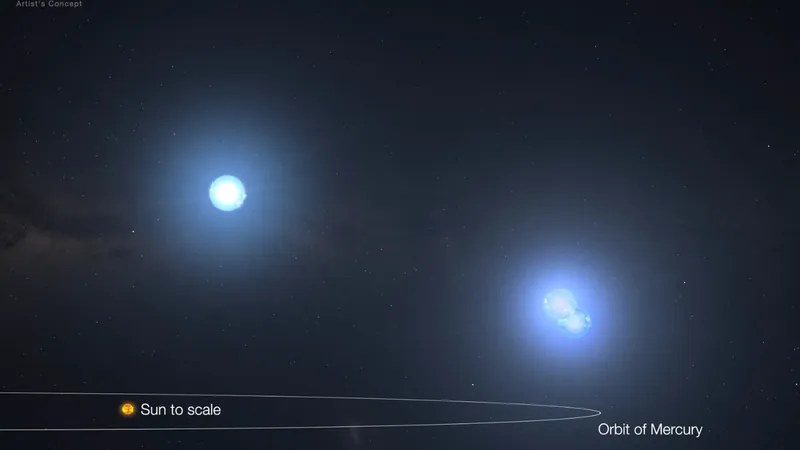
NASA's TESS Discovers a Mind-Blowing Triple-Star System—Could There Be More?
2024-10-04
Introduction
In an astonishing breakthrough, NASA's Transiting Exoplanet Survey Satellite (TESS) has discovered a record-breaking triple-star system known as TIC 290061484, nestled just under 5,000 light-years away in the constellation Cygnus. This strikingly compact system comprises twin stars orbiting each other every 1.8 Earth days, complemented by a third star that completes its orbit every 25 days. Remarkably, this trio could easily fit within the space between our sun and Mercury!
This discovery shatters previous records. The former titleholder, Lambda Tauri, had its third star orbiting its inner twins every 33 days—a stark contrast to the swift choreography of TIC 290061484.
A Stellar Team Effort
The remarkable find was made possible thanks to a dedicated group of both citizen scientists and professional astronomers who collaborated through the Visual Survey Group. Their efforts date back to the Planet Hunters project, which, despite concluding in 2013, left a lasting impact.
Team member Veselin Kostov from NASA's Goddard Space Flight Center emphasized the significance of this unique alignment: "Thanks to the compact, edge-on configuration of the system, we can measure the orbits, masses, sizes, and temperatures of its stars," he explained. This precise measurement allows scientists to delve into the formation and evolution of the system.
The Future of TIC 290061484
The stability of TIC 290061484 is noteworthy, as the stars orbit in nearly the same plane, reducing the chance of chaotic gravitational influences that could destabilize their interactions. However, as Rappaport highlights, “No one lives here.” The imminent fate of this trio may lead to a spectacular supernova in around 20 to 40 million years when the twin stars—aging and expanding—will merge explosively. Fortunately, any nearby planets—if they exist—are too distant to harbor life as we understand it.
Interestingly, the researchers suggest that a distant planet could still exist within this stellar system, orbiting the trio as if they were one large star.
Harnessing Technology for Discovery
The groundbreaking discovery was facilitated by the detection of strobing starlight caused by the stars passing in front of one another, a phenomenon that reached the observatory's notice thanks to advanced machine learning techniques. This technology allows scientists to sift through mountains of TESS data, identifying potential candidates for further observation.
Rappaport noted, “We’re mainly looking for signatures of compact multi-star systems, unusual pulsating stars in binary systems, and weird objects." Given how rare they are believed to be, the discovery of TIC 290061484 is momentous, yet the team suspects many more such systems are waiting to be uncovered across the Milky Way.
An Exciting Future with Roman Telescope
Hope is on the horizon with the Nancy Grace Roman Space Telescope set to launch by May 2027. This next-generation telescope will offer an unprecedented detail of the cosmos, surpassing TESS’s broader view. The improvement in resolution—a staggering increase of about 36,000 times for specific areas of space—will be a game-changer. As Brian Powell from Goddard points out, Roman will help resolve stars that currently blur together, shedding light on their nature and behaviors.
With a keen focus on monitoring light from hundreds of millions of stars, Roman aims to unveil phenomena like the light changes that led to the discovery of TIC 290061484. Powell also speculated about Roman's potential: Could it identify tightly packed systems with more than three stars, perhaps even six?
The notion of undiscovered star systems with even more complex interactions challenges our understanding of the cosmos. As Astronomers like Tamás Borkovits point out, the existence of triply eclipsing triple-star systems was once considered improbable; now they ask, "Why stop there?"
Conclusion
This exhilarating discovery reminds us that the universe is full of surprises, and NASA's explorations are only beginning to scratch the surface. Keep your eyes on the stars—it might just reveal secrets we never thought possible!



 Brasil (PT)
Brasil (PT)
 Canada (EN)
Canada (EN)
 Chile (ES)
Chile (ES)
 España (ES)
España (ES)
 France (FR)
France (FR)
 Hong Kong (EN)
Hong Kong (EN)
 Italia (IT)
Italia (IT)
 日本 (JA)
日本 (JA)
 Magyarország (HU)
Magyarország (HU)
 Norge (NO)
Norge (NO)
 Polska (PL)
Polska (PL)
 Schweiz (DE)
Schweiz (DE)
 Singapore (EN)
Singapore (EN)
 Sverige (SV)
Sverige (SV)
 Suomi (FI)
Suomi (FI)
 Türkiye (TR)
Türkiye (TR)